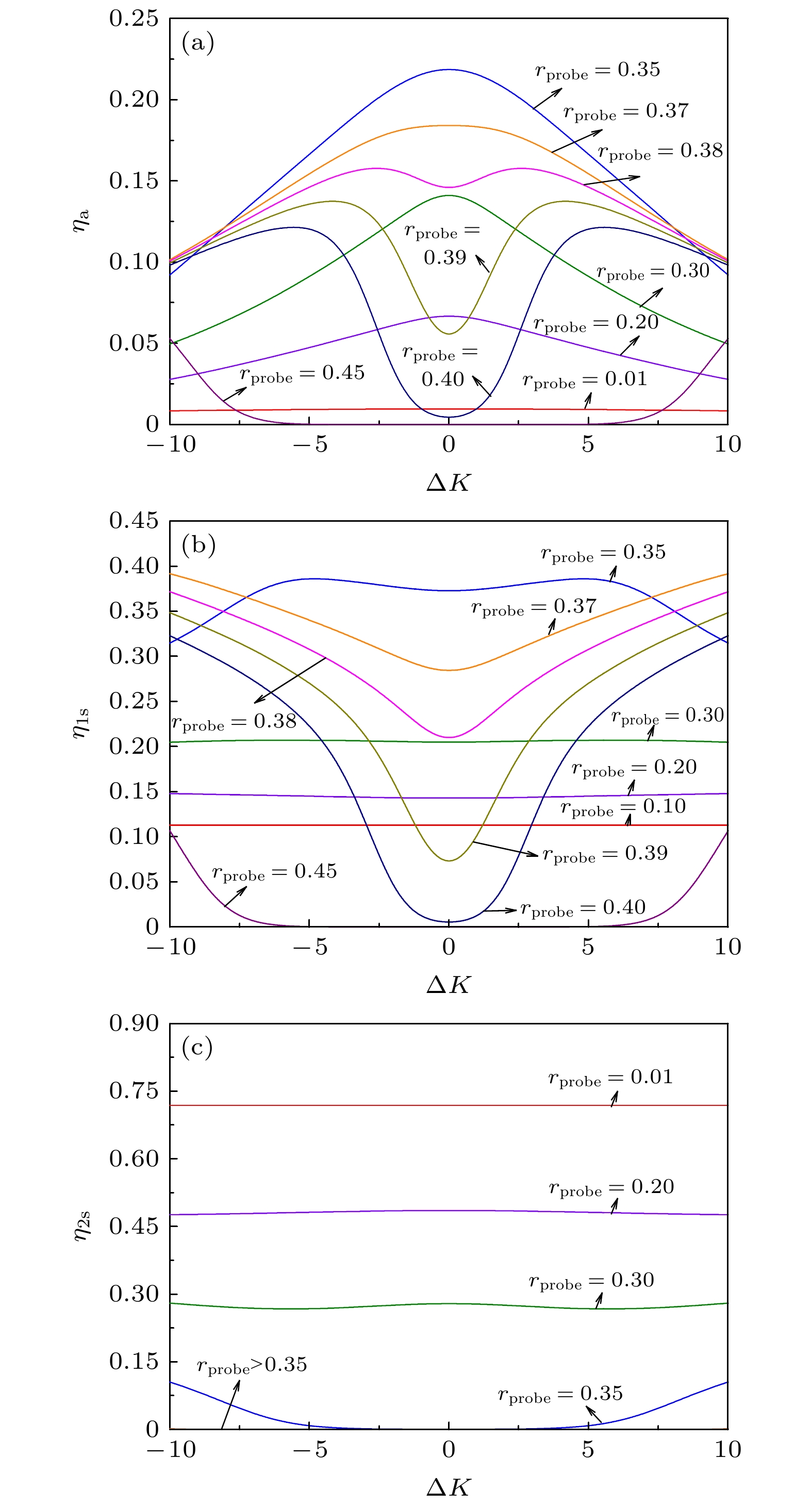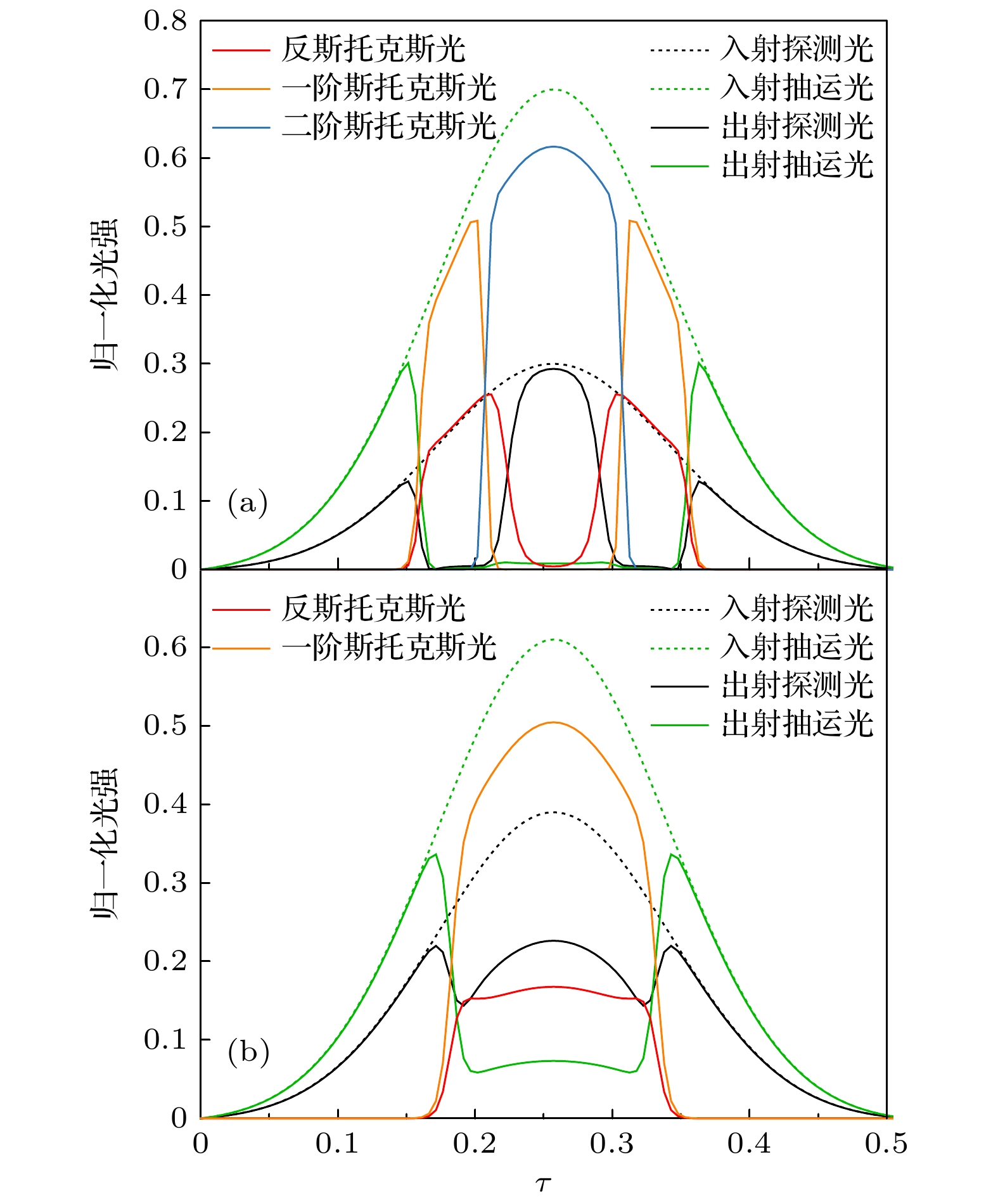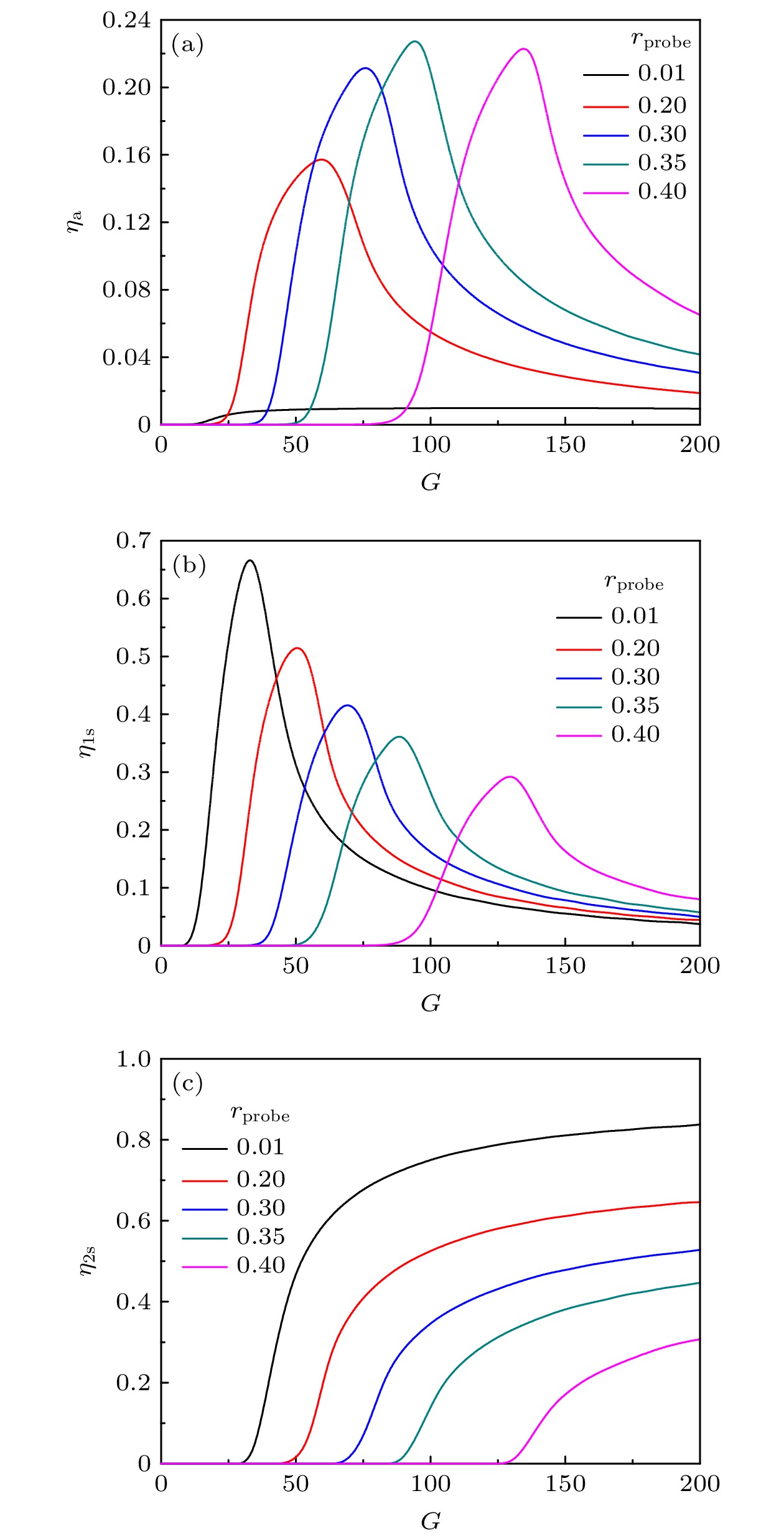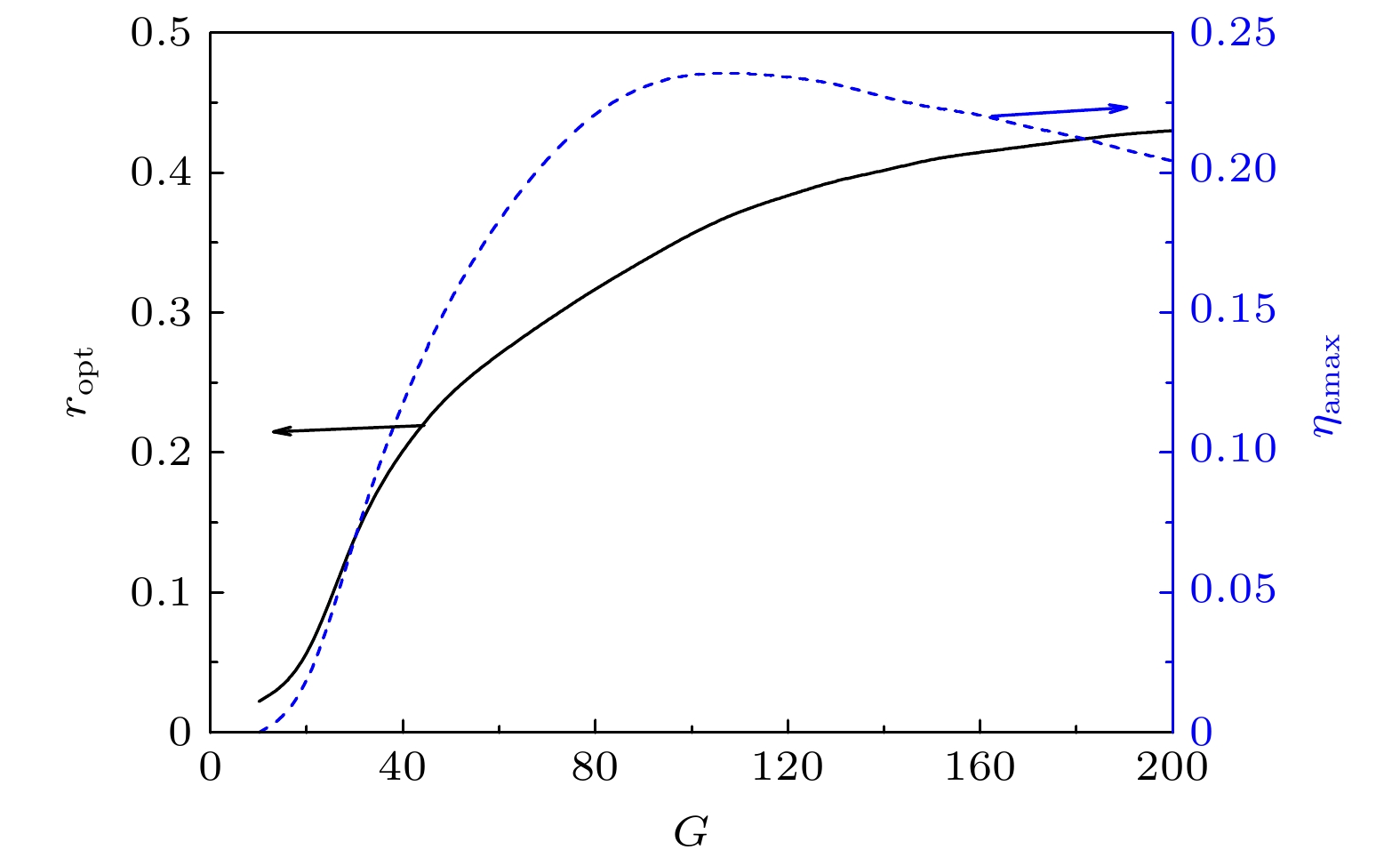-
采用拉曼频移器在晶体介质中利用相干反斯托克斯散射效应可以获得超短脉冲(皮秒)反斯托克斯激光. 基于抽运-探测法的晶体拉曼频移器可以实现相干反斯托克斯散射的共线相互作用, 从而可以有效提高反斯托克斯光的转化效率. 本文在平面波近似下建立了基于抽运-探测法的皮秒反斯托克斯拉曼频移器的耦合波方程组, 引入归一化参量对方程组进行了归一化处理. 通过数值计算, 得到了描述皮秒反斯托克斯拉曼频移器运行的一组普适理论曲线, 分析了归一化拉曼增益系数G、归一化相位失配参数ΔK以及探测光脉冲能量占基频光总能量的比值rprobe三个变量对反斯托克斯拉曼频移器性能的影响, 确定了实现高效反斯托克斯转化时各归一化变量的合理取值. 采用实验数据对该理论模型的正确性进行了验证, 反斯托克斯转化效率的理论值与文献数据基本一致.Ultra-short pulse (picosecond) anti-Stokes laser can be obtained by using Raman frequency converter in a crystal medium by the coherent anti-Stokes Raman scattering effect. The crystalline Raman frequency converter based on the pump-probe method can realize the collinear interaction of coherent anti-Stokes Raman scattering, thus effectively improving the conversion efficiency of the anti-Stokes light. Theoretical simulation is an important means to study laser operation. Coupled wave equation is widely used to study the characteristics of Raman laser and anti-Stokes laser. Although the coupling wave theory of anti-Stokes Raman frequency shifter reported previously can reflect the operation law of the frequency shifter, the optimization of the frequency shifter and the influence of the frequency shifter parameters on the output characteristics of anti-Stokes laser have not been reported so far. In this paper, the picosecond anti-Stokes Raman frequency converter based on the pump-probe method is studied theoretically. Considering the generation of the first Stokes light in the probe channel and the second Stokes light in the pump channel, the coupled wave equation of the collinear picosecond anti-Stokes Raman frequency converter is established under the plane wave approximation. Without loss of generality, four dimensionless comprehensive parameters are introduced to normalize the equations. A set of universal theoretical curves describing the operation of the Raman frequency converter is obtained. The numerical solutions of the equations show that the performance of the Raman frequency converter mainly depends on three parameters: the normalized phase mismatch parameter ΔK, the normalized Raman gain coefficient G, and the energy ratio of the probe light to the fundamental light rprobe. The reasonable values of normalized variables are determined when the high efficiency anti-Stokes conversion is realized. Experimental data are used to verify the correctness of the theoretical model. The theoretical value of the anti-Stokes conversion efficiency is basically consistent with the literature data. The normalized coupled wave theory proposed in this paper is helpful in understanding the operation law of the picosecond anti-Stokes Raman frequency shifter, and has guiding significance for the design of the frequency converter.
-
Keywords:
- coherent anti-Stokes scattering /
- collinear four-wave mixing /
- coupled wave equation /
- normalization theory
[1] 孙瑛璐, 段延敏, 程梦瑶, 袁先漳, 张立, 张栋, 朱海永 2020 物理学报 69 124201
 Google Scholar
Google Scholar
Sun Y L, Duan Y M, Cheng M Y, Yuan X Z, Zhang L, Zhang D, Zhu H Y 2020 Acta Phys. Sin. 69 124201
 Google Scholar
Google Scholar
[2] 张蕴川, 樊莉, 魏晨飞, 顾晓敏, 任思贤 2018 物理学报 67 024206
 Google Scholar
Google Scholar
Zhang Y C, Fan L, Wei C F, Gu X M, Ren S X 2018 Acta Phys. Sin. 67 024206
 Google Scholar
Google Scholar
[3] Zhou Q Q, Shi S C, Chen S M, Duan Y M, Zhang X M, Guo J, Zhao B, Zhu H Y 2019 Chin. Phys. Lett. 36 014205
 Google Scholar
Google Scholar
[4] Sheng Q, Li R, Lee A J, Spence D J, Pask H M 2019 Opt. Express 27 8540
 Google Scholar
Google Scholar
[5] Wei L J, Chen M T, Zhu S Q, Dai S B, Yin H, Chen Z Q 2018 Laser Phys. Lett. 15 125001
 Google Scholar
Google Scholar
[6] Duan Y M, Sun Y L, Zhu H Y, Mao T W, Zhang L, Chen X 2020 Opt. Lett. 45 2564
 Google Scholar
Google Scholar
[7] Liu J, Ding X, Jiang P B, Sheng Q, Yu X Y, Sun B, Wang J B, Shi R, Zhao L, Bai Y T, Zhang G Z, Wu L, Yao J Q 2018 Appl. Opt. 57 3154
 Google Scholar
Google Scholar
[8] Ding S H, Zhang X Y, Wang Q P, Jia P, Zhang C, Liu B 2006 Opt. Commun. 267 480
 Google Scholar
Google Scholar
[9] Smetanin S N, Doroshenko M E, Ivleva L I, Jelínek M, V. Kubeček, Jelínková H 2014 Appl. Phys. B 117 225
 Google Scholar
Google Scholar
[10] Ding S H, Zhang X Y, Wang Q P, Zhang J, Wang S M, Liu Y R, Zhang X H 2007 J. Phys. D 40 2736
[11] Smetanin S N, Jelínek M, Tereshchenko D P, Kubeček V 2018 Opt. Express 26 22637
 Google Scholar
Google Scholar
[12] Smetanin S N, Jelínek M, Kubeček V 2017 Appl. Phys. B 123 203
[13] Vermeulen N, Debaes C, Fotiadi A A, Panajotov K, Thienpont H 2006 IEEE J. Quantum Electron. 42 1144
 Google Scholar
Google Scholar
[14] Grasiuk A Z, Kurbasov S V, Losev L L 2004 Opt. Commun. 240 239
 Google Scholar
Google Scholar
[15] Mildren R P, Coutts D W, Spence D J 2009 Opt. Express 17 810
 Google Scholar
Google Scholar
[16] Wang C, Zhang X Y, Wang Q P, Cong Z H, Liu Z J, Wei W, Wang W T, Wu Z G, Zhang Y G, Li L, Chen X H, Li P, Zhang H J, Ding S H 2013 Opt. Express 21 26014
 Google Scholar
Google Scholar
[17] Wang C, Cong Z H, Qin Z G, Zhang X Y, Wei W, Wang W T, Zhang Y G, Zhang H J, Yu H H 2014 Opt. Commun. 322 44
 Google Scholar
Google Scholar
[18] Wei W, Zhang X Y, Wang Q P, Wang C, Cong Z H, Chen X H, Liu Z J, Wang W T, Wu Z G, Ding S H, Tu C Y, Li Y F, Cheng W Y 2014 Appl. Phys. B 116 561
[19] Smetanin S N, Jelínek M, Tereshchenko D P, Shukshin V E, Konyukhov M V, Papashvili A G, Voronina I S, Ivleva L I, Kubeček V 2020 Opt. Express 28 22919
 Google Scholar
Google Scholar
[20] Shen Y R, Bloembergen N 1965 Phys. Rev. 137 1787
 Google Scholar
Google Scholar
-
图 3 rprobe = 0.3, G = 90, Wp = 0.2时, 抽运光、探测光、一阶斯托克斯光和反斯托克斯光归一化光强随ζ的空间演化 (a) |ΔK| = 0; (b) |ΔK| = 4; (c) |ΔK| = 8
Fig. 3. Plots of the spatial evolution of pump, probe, first Stokes, and anti-Stokes normalized intensities with rprobe = 0.3, G = 90 and Wp = 0.2: (a) |ΔK| = 0; (b) |ΔK| = 4; and (c) |ΔK| = 8.
图 4 rprobe = 0.39, G = 90, Wp = 0.2时, 抽运光、探测光、一阶斯托克斯光和反斯托克斯光归一化光强随ζ的空间演化 (a) |ΔK| = 0; (b) |ΔK| = 4; (c) |ΔK| = 8
Fig. 4. Plots of the spatial evolution of pump, probe, first Stokes, and anti-Stokes normalized intensities with rprobe = 0.39, G = 90 and Wp = 0.2: (a) |ΔK| = 0; (b) |ΔK| = 4; and (c) |ΔK| = 8.
图 8 |ΔK| = 0, Wp = 0.2时抽运光、探测光、一阶斯托克斯光、二阶斯托克斯光和反斯托克斯光的脉冲形状 (a) ropt = 0.270, G = 60; (b) ropt = 0.373, G = 110; (c) ropt = 0.414, G = 160
Fig. 8. Temporal profiles of the pump, probe, first Stokes, second Stokes, and anti-Stokes pulses with |ΔK |= 0 and Wp = 0.2: (a) ropt = 0.270, G = 60; (b) ropt = 0.373, G = 110; (c) ropt = 0.414, G = 160.
参数 值 参数 值 νa/νp 1.06 Ap/cm2 2.83 × 10–4 ν1s/νp 0.94 lR/cm 3.2 ν2s/νp 0.88 g/(cm·GW–1) 13 wp/ps 20 Δk 0 表 2 不同情况下反斯托克斯转化效率的理论值与实验数据的对比结果
Table 2. Comparisons of theoretical and experimental results of anti-Stokes conversion efficiency under different conditions.
抽运脉冲
能量/μJ探测脉冲
能量/μJG rprobe 实验
值/%理论
值/%30 25 206 0.45 2.80 2.54 30 2 118 0.063 1.88 1.86 26 12 140 0.32 3.50 4.13 表 3 高斯近似时反斯托克斯转化效率的理论值
Table 3. Theoretical values of anti-Stokes conversion efficiency for Gaussian approximation.
抽运脉冲能量/μJ 探测脉冲能量/μJ $ \eta _{\rm{a}}^{\rm{g}}$/% 30 25 2.63 30 2 1.91 26 12 4.09 -
[1] 孙瑛璐, 段延敏, 程梦瑶, 袁先漳, 张立, 张栋, 朱海永 2020 物理学报 69 124201
 Google Scholar
Google Scholar
Sun Y L, Duan Y M, Cheng M Y, Yuan X Z, Zhang L, Zhang D, Zhu H Y 2020 Acta Phys. Sin. 69 124201
 Google Scholar
Google Scholar
[2] 张蕴川, 樊莉, 魏晨飞, 顾晓敏, 任思贤 2018 物理学报 67 024206
 Google Scholar
Google Scholar
Zhang Y C, Fan L, Wei C F, Gu X M, Ren S X 2018 Acta Phys. Sin. 67 024206
 Google Scholar
Google Scholar
[3] Zhou Q Q, Shi S C, Chen S M, Duan Y M, Zhang X M, Guo J, Zhao B, Zhu H Y 2019 Chin. Phys. Lett. 36 014205
 Google Scholar
Google Scholar
[4] Sheng Q, Li R, Lee A J, Spence D J, Pask H M 2019 Opt. Express 27 8540
 Google Scholar
Google Scholar
[5] Wei L J, Chen M T, Zhu S Q, Dai S B, Yin H, Chen Z Q 2018 Laser Phys. Lett. 15 125001
 Google Scholar
Google Scholar
[6] Duan Y M, Sun Y L, Zhu H Y, Mao T W, Zhang L, Chen X 2020 Opt. Lett. 45 2564
 Google Scholar
Google Scholar
[7] Liu J, Ding X, Jiang P B, Sheng Q, Yu X Y, Sun B, Wang J B, Shi R, Zhao L, Bai Y T, Zhang G Z, Wu L, Yao J Q 2018 Appl. Opt. 57 3154
 Google Scholar
Google Scholar
[8] Ding S H, Zhang X Y, Wang Q P, Jia P, Zhang C, Liu B 2006 Opt. Commun. 267 480
 Google Scholar
Google Scholar
[9] Smetanin S N, Doroshenko M E, Ivleva L I, Jelínek M, V. Kubeček, Jelínková H 2014 Appl. Phys. B 117 225
 Google Scholar
Google Scholar
[10] Ding S H, Zhang X Y, Wang Q P, Zhang J, Wang S M, Liu Y R, Zhang X H 2007 J. Phys. D 40 2736
[11] Smetanin S N, Jelínek M, Tereshchenko D P, Kubeček V 2018 Opt. Express 26 22637
 Google Scholar
Google Scholar
[12] Smetanin S N, Jelínek M, Kubeček V 2017 Appl. Phys. B 123 203
[13] Vermeulen N, Debaes C, Fotiadi A A, Panajotov K, Thienpont H 2006 IEEE J. Quantum Electron. 42 1144
 Google Scholar
Google Scholar
[14] Grasiuk A Z, Kurbasov S V, Losev L L 2004 Opt. Commun. 240 239
 Google Scholar
Google Scholar
[15] Mildren R P, Coutts D W, Spence D J 2009 Opt. Express 17 810
 Google Scholar
Google Scholar
[16] Wang C, Zhang X Y, Wang Q P, Cong Z H, Liu Z J, Wei W, Wang W T, Wu Z G, Zhang Y G, Li L, Chen X H, Li P, Zhang H J, Ding S H 2013 Opt. Express 21 26014
 Google Scholar
Google Scholar
[17] Wang C, Cong Z H, Qin Z G, Zhang X Y, Wei W, Wang W T, Zhang Y G, Zhang H J, Yu H H 2014 Opt. Commun. 322 44
 Google Scholar
Google Scholar
[18] Wei W, Zhang X Y, Wang Q P, Wang C, Cong Z H, Chen X H, Liu Z J, Wang W T, Wu Z G, Ding S H, Tu C Y, Li Y F, Cheng W Y 2014 Appl. Phys. B 116 561
[19] Smetanin S N, Jelínek M, Tereshchenko D P, Shukshin V E, Konyukhov M V, Papashvili A G, Voronina I S, Ivleva L I, Kubeček V 2020 Opt. Express 28 22919
 Google Scholar
Google Scholar
[20] Shen Y R, Bloembergen N 1965 Phys. Rev. 137 1787
 Google Scholar
Google Scholar
计量
- 文章访问数: 6961
- PDF下载量: 62
- 被引次数: 0














 下载:
下载:








